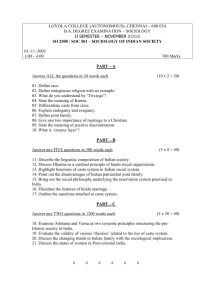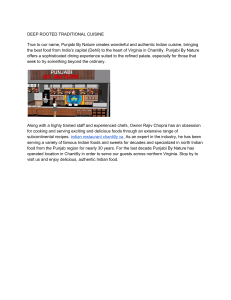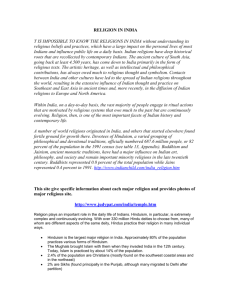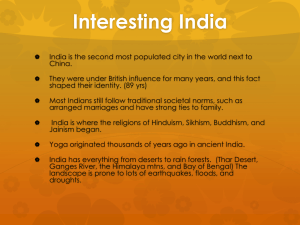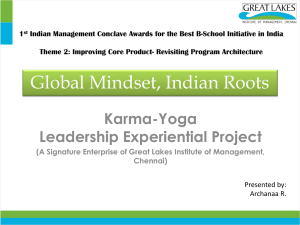Document
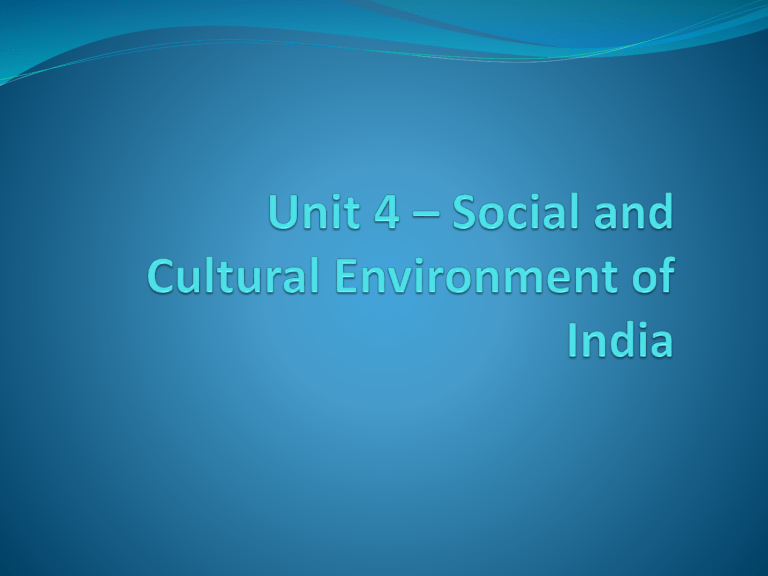
What is CULTURE? What impact does it have on business?
“the collective programming of the mind which distinguishes the members of one human group over another…
Culture, in this sense, includes systems of values; and values are among the building blocks of culture”
Know local culture to sell or market the product
Build relationships while setting up business (with employees as well as customers).Employ locals to gain cultural knowledge. Help employees understand you
Non-Verbal Gestures
Italy – What exactly do you mean?
Greece – That’s just perfect
Egypt – Be patient
Salient features of Indian Society
Rich culture
Religiously diverse
Social Hierarchy
Joint Family – Nuclear family
Neo urban culture
Cricket and bollywood
Dimensions of Cultural Diversity in
India
•Language
•Rural vs. Urban India
•Rich vs. Poor
•Geographical diversity
•Liberal vs. Conservative
Class and Caste structure of Indian
Society
4 Varnas = Jati
In India , a caste system organizes division of labour and money in human society. It is a system of social stratification and basis of affirmative action
Secularism in Indian Society
No State Religion-Separation of State and
Religion,
Peaceful co-existence of all religions,
Treatment of all religions equally by the State,
Equality of opportunity in the public field for all irrespective of caste or creed or race or religion ensuring equal citizenship,
Freedom of religion both individual and corporate
Rural and Urban Differences
Joint Family System
India has had a prevailing tradition of the joint family system. It is a system under which extended members of a family – parents, children, the children’s spouses and their offspring, etc. – live together. Usually, the oldest male member is the head in the joint Indian family system. He makes all important decisions and rules, and other family members abide by them.
Over the last 60 years, the cultural trend in most parts of
India has been an accelerated change from joint family to nuclear families, much like population trends in other parts of the world.
Youth in lower socio-economic classes are more inclined to spend time with their families than their peers due to differing ideologies in rural and urban parenting.
Business Participation in Social and
Cultural affairs
Support to cultural activities
Empowering artists and musicians
Organizing exhibitions of contemporary paintings
Sponsoring cultural programs through TV
Sangeet sammelan by ITC
Beauty in building design
Earlier infrastructure was based on utilitarian concept
Factories now constructed keeping in mind aesthetic values – industrial parks,gardens etc
This provides better quality of life to community
Better Place for their children
Encourages each employee’s own cultural growth
Improvement of entire social system
Size and growth rate of population
High population growth rate implies increase in labour supply. The falling birth rate and rising longevity will alter the age distribution in the population.
The changes in the age distribution have a lot of implications for the business. The pharmaceutical companies may pay attention to the requirements of the aged population. Increasing proportion of the aged would have implications for the government. It may increase the welfare burden of the governments.
Age structure of Population
7-25 years - Study and focus on education (extreme poverty can drive some to unfortunate child labor)
25-50 - Get married, raise a family and enjoy all that the world has to offer
50-75 - Retire and focus on spiritual pursuits and pilgrimages (People take pilgrimages to Varanasi, Mecca
(Haj), Himalayas, Amritsar, focus on Meditation, Yoga)
75- end - Help take care of grandchildren and share your experiences with youngsters.
Demographic dividend and its impact on business and growth
Demography studies how populations changes overtime, in terms of size and structure.
The demographic variables that affect business are overall:
- Size of the population
- Age and sex of the population
- Ethnicity and geographical distribution
- Birth rate
- Death rate
- Net migration
Business and Culture : Religion,
India is the birthplace of Hinduism , Buddhism , Jainism and Sikhism , collectively known as Indian religions.
[4] India is one of the most religiously diverse nations in the world, with some of the most deeply religious societies and cultures. Religion still plays a central and definitive role in the life of many of its people.
Religious beliefs , customs , sentiments etc have important implications for business
Religions play important role in deciding holiday and starting important work ventures
Influence attitude towards work and wealth
Riba in Koran
Astrological dates , festive and marriage season raises demand
Automobile spare part business dominated by Sikhs, money lending by
Chettiars in Tamil Nadu, Punjabi Restaurants – Punjabi By Nature,
Spanish Restaurant – Imperfecto, Chinese Restaurant – Yo china ;
Mainland China
Business and Culture : language
Switzerland – 3 Languages – French , Italian , German
India – 18 Recognized Languages
Ford- Truck Name – Fiera(Ugly old woman in Spanish)
Chevrolet Nova (Spanish Meaning – it doesn’t go)
Pat on shoulder offensive in Thailand
Business and Culture - OB
Centralized vs Decentralized decision making
Safety vs Risk
Individual vs Group reward
Informal vs Formal Procedure
High vs low Orgaizational Loyalty
Cooperation vs Competition
Short term vs Long term Horizon
Stability vs Innovation
OB Differences
Other Socio Cultural Factors
Consumer Preferences Habits and Beliefs
Western: “The early bird gets the worm”
Eastern:
“The first bird in the flock gets shot”
Nescafe – ¾ share in Mumbai Mkt , insignificant in Chennai
Bicycles – Developing countries – Basic means of transportation
Developed countries – Means to stay fit and healthy
Food habits, Juices, Coca Cola
Etiquettes
Color – White
Rise in % of women workforce – double income, single parent
Technological development and
Social Change
Development of new techniques, new inventions reflect changing knowledge , beliefs and norms and new standards of living
Women – Differentiated tasks, differentiated earnings, new home appliances
Transport, communication made suburbanization possible
Films , TV Radio have become very helpful in transmission and diffusion of information, Reduction of social distance
More industrialized and materialistic society - severe blow to casteism
AC , dams – change in natural environment
Also have adverse effects like pollution ; global warming etc
The Indian Touch
Fordcars specially designed for Indian roads.
•Electrolux'smade‐for‐India fridge–chill drinking water, keeps food fresh & withstands long power cuts.
•Samsung–microwave oven with grill.
•Nokialaunched a handset “Made for India”Nokia 1100.
•McDonald’s McAlooTikkiBurger & Pizza McPuff.
•Cartoon Networkintroduced South Indian folk tale
“TenaliRam”.
•Walt Disneycartoon TV shows are in Hindi.

